Jacques d'Adelswärd-Fersen
Baron Jacques d'Adelswärd-Fersen (20 February 1880 – 5 November 1923) was a French novelist and poet. His life forms the basis of a fictionalised 1959 novel by Roger Peyrefitte entitled The Exile of Capri (L'exilé de Capri).
Baron Jacques d'Adelswärd-Fersen | |
|---|---|
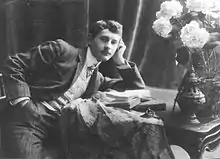 D'Adelswärd-Fersen in 1905 | |
| Born | 20 February 1880 Paris, France |
| Died | 5 November 1923 (aged 43) Capri, Italy |
| Resting place | Cimitero acattolico ("Non-Roman-Catholic cemetery"), Capri[1] 40.5514°N 14.2345°E |
| Occupation(s) | Writer and poet |
| Known for | Lord Lyllian Akademos Being the subject of Roger Peyrefitte's novel L'Exilé de Capri |
| Partner(s) | Nino Cesarini Corrado Annicelli |
| Signature | |
 | |
In 1903, a scandal involving school pupils made d'Adelswärd persona non grata in the salons of Paris and dashed his marriage plans. For much of the rest of his life, he took up residence on Capri in self-imposed exile with his long-time lover, Nino Cesarini. He became a "character" on the island in the inter-war years, featuring in novels by Compton MacKenzie and others. His house, Villa Lysis, remains one of Capri's tourist attractions.
Early life
He was born in Paris, France, as Jacques d'Adelswärd, on 20 February 1880, son of Axel d'Adelswärd and Louise-Emilie Alexandrine d'Adelswärd (née Vührer). As he was related on his paternal side to Axel von Fersen, a Swedish count who had had a supposed relationship with Marie Antoinette, d'Adelswärd took on the name Fersen later in his life to advertise his link with his distant relative. D'Adelswärd's grandfather had founded the steel industry in Longwy-Briey. D'Adelswärd went to school in Paris and studied briefly there at the École libre des sciences politiques, and afterward at the University of Geneva. His mother, Louise-Emilie (1855-1935), came from a Catholic Alsatian family. D'Adelswärd's maternal grandfather, Thomas Michel Alexandre Vührer (1817-1886), was a referendary at the French Ministry of State, director of Le Paris-Journal as well as founder of the Parisian newspaper Le Soir. D'Adelswärd's father died when he was seven years old. He was assigned a guardian, Viscount Elie Marie Audoin de Dampierre (1846-1909), who was a friend of the family. During d'Adelswärd's teenage years, the family spent long summer vacations at his grandfather's estate on Jersey, where d'Adelswärd reportedly had an intimate encounter with a blond Eton schoolboy.[2]
In 1897, d'Adelswärd visited Capri and other parts of Italy with his mother. The family steel furnaces had become profitable enough to make d'Adelswärd a rich and 'eligible' bachelor when he inherited at the age of 22. Apart from joining the military, he travelled extensively and settled down as a writer. He published Chansons légères (1900) and Hymnaire d'Adonis (1902) and other poems and novels. In 1902 he holidayed in Venice, where he associated with the novelist Jean Lorrain. On his return to Paris, he published a novel, Notre Dame des mers mortes.
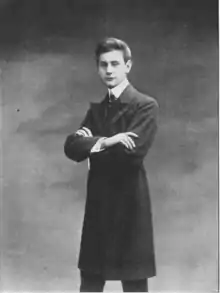
'Messes noires' scandal
In 1903, d'Adelswärd and his friend, Albert François (Hamelin) de Warren (1881-1928), brother of Rene de Warren, were rumoured to be holding "entertainments" – tableaux vivants of pupils from the best Parisian schools – in his house at 18 Avenue de Friedland.[2] One of the first alleged "victims" was Eduardo (Bruno) de Warren (1886-1957), brother of Hamelin.[3] D'Adelswärd and Hamelin were arrested on charges of inciting minors to commit debauchery. d'Adelswärd was arrested on 9 July by Octave Hamard, chief of the Paris police and his deputy Blot by order of Charles de Valles, pretrial judge. The order stated the suspicion of indecent behaviour with minors and offending the public decency. He was brought to La Santé Prison after arrest. The newspapers and magazines published alleged details of d'Adelswärd's and Hamelin's orgies, which they called Messes noires (Black Masses) in their homes twice a week, with youngsters from the upper classes, mostly recruited from the Lycée Carnot, and Chaptal, Condorcet, Janson-deSailly and Saint-Joseph-des-Tuileries schools.
According to Peyrefitte, the scandal started with a failed blackmail attempt by d'Adelswärd's former servant demanding 100,000 francs in return for his silence. D'Adelswärd's mother refused to pay, so he went to the police. At the beginning, the police dismissed the allegations. But the story was later confirmed by another arrested blackmailer who was an intimate acquaintance of Albert François de Warren. Will Ogrinc reported that after investigating the French National Archives in 2003, he did not come across any documents about the failed blackmail attempt by d'Adelswärd's former valet, and that it was probably invented by Peyrefitte. In the court documents, the valet, whose name was Velpry, told investigators about the periodic visits of brothers Croisé de Pourcelet to d'Adelswärd's apartment, and that after one of their visits, he had found obscene photos and handkerchiefs stained with semen on the table. He also claimed that he had let d'Adelswärd's mother know about it and quit his job. Some documents mention that d'Adelswärd was blackmailed by several rent boys with whom he had relations. The dossier mentions the names of six rent boys: Beret, Boscher, twenty-one-year-old Kothé, Lefebvre, nineteen-year-old Leroy, and fifteen-year-old Verguet, though there is no mention as to which of them might have been the blackmailer.
Police started to watch some of the schoolboys, which at first sight confirmed the allegations. Hamelin fled to the United States on 27 June 1903, but d'Adelswärd was arrested. His aunt Jeanne d'Adelswärd and former guardian Viscount Audoin de Dampierre employed Edgar Demange, a lawyer who previously defended Alfred Dreyfus, in his defence.
Trial
The trial started on 28 November 1903 in the Seine Tribunal. It was presided over by Judge Bondoux. It was a closed trial with the public barred from the hearings. Some schoolboys testified for the prosecution. The defence tried to prove d'Adelswärd's heterosexuality by making him testify about his encounters with women.[4] D'Adelswärd and de Warren were found guilty, but having been in prison for five months already d'Adelswärd was set free immediately after the trial. He was also fined 50 francs and lost civil rights for five years. Hamelin stayed in prison and appealed his sentence to a higher court. The "entertainments" had been attended by the cream of Parisian society, including some Catholic priests and the writer Achille Essebac. This could be a factor which may have induced the court to drop some charges. According to Will Ogrinc, the court limited the case to "inciting minors to debauchery" because of illegal conduct between boys and two young men in their twenties, preventing implications against older participants. Many boys did not appear at the interrogations and trial, since they had been sent to the countryside by their parents to avoid embarrassing revelations.
There is no detailed description of the boys' testaments, but Peyrefitte mentions Jean Lorrain's report in his memoirs Propos Secrets, that after tableaux vivants d'Adelswärd followed the boys who had been stimulated by the entertainment to the bathroom and masturbated them.[5]
Failed marriage
The scandal foiled d'Adelswärd's plans to marry Blanche Suzanne Caroline de Maupeou (1884-1951), a daughter of the respected aristocratic and wealthy Protestant industrialist Viscount de Maupeou.[6] The court documents mention that one of the blackmail letters was sent to the Viscount prior to the scandal, and that Blanche's family was happy to receive the information prior to his arrest and to cancel his marriage plans. After d'Adelswärd's release on 3 December 1903, he tried to visit his fiancée, with the intent of explaining the affair, but was sent away by a servant. There were rumours in the press that he tried to end his life, but the accounts in Gazzetta Piemontese and Le Figaro differ.
On Capri
Construction of Villa Lysis and world travels
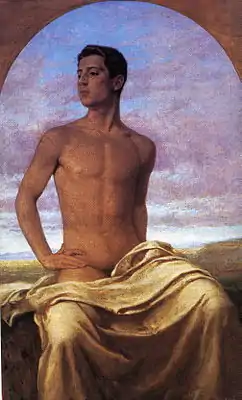
%252C_Capri%252C_1905.jpg.webp)
.jpg.webp)
After his marriage plans were foiled, d'Adelswärd remembered the island of Capri from his youth, and decided to build a house there. The island had already attracted other homosexual or bisexual visitors, such as Christian Wilhelm Allers, Somerset Maugham, E. F. Benson, Lord Alfred Douglas, Robert Ross, Oscar Wilde, Friedrich Alfred Krupp, Norman Douglas, and Compton and Faith Mackenzie; and attracted many others during d'Adelswärd's stay. He stayed originally at the Grand Hotel Quisisana and then bought land at the top of a hill in the northeast of the island, close to where the Roman emperor Tiberius had built his Villa Jovis two millennia earlier. He commissioned his friend Édouard Chimot to design a villa, initially called Gloriette, but was eventually christened Villa Lysis (later sometimes referred to as Villa Fersen) in reference to Plato's Socratic dialogue Lysis discussing friendship (or, according to modern notions, homosexual love). When the construction started, d'Adelswärd left Capri to visit the Far East. He mostly spent time on Ceylon, where he wrote Lord Lyllian. He returned to Capri in the autumn of 1904, visiting the United States on the way back.
At some point after his return, he had to flee Capri temporarily, since some islanders blamed d'Adelswärd for a local worker's accidental death during the construction of Villa Lysis. He went to Rome, where he met a fourteen-year-old construction worker selling newspapers, Nino Cesarini. D'Adelswärd fell in love with the boy immediately. He obtained Cesarini's family's permission to take him as secretary. In the spring of 1905 d'Adelswärd and Cesarini visited Sicily, where they met with Wilhelm von Gloeden in Taormina.
The construction of the villa was completed in July 1905. Villa Lysis is a notable building. Its style is described by some as "Liberty" but is not Liberty or Art Nouveau in the French manner but may perhaps be described as "Neoclassical decadent". The large garden is connected to the villa by steps leading to an Ionic portico. In the atrium a marble stairway with wrought-iron balustrade leads to the first floor, where there are bedrooms with panoramic terraces, and a dining room. The ground-floor sitting-room, decorated with blue majolica and white ceramic, overlooks the Gulf of Naples. In the basement there is a 'Chinese Room', in which opium was smoked.
D'Adelswärd and Cesarini travelled to Paris, where d'Adelswärd delivered a manuscript to publishers and went directly to Oxford. After returning to Capri, d'Adelswärd, Cesarini and their four boy-servants travelled to China. They all returned to Villa Lysis at the beginning of 1907.
Temporary exile from Capri
D'Adelswärd published his novel about Capri Et le feu s'éteignit sur la mer… ('And the fire was smothered by the sea') in 1909. The novel told the story of young sculptor Gérard Maleine on Capri. The book was highly criticized, since d'Adelswärd wrote quite frivolously about Caprian habits and morals. Some islanders, recognising themselves in the book, tried to prevent its distribution. Roberto Ciuni reports that the Communal Council of Capri decided to pursue d'Adelswärd's expulsion from the island at its formal meeting on 16 September 1909. Villa Lysis and its inhabitants had a nasty reputation among locals. Giorgio Amendola, the future leader of the Italian Communist Party, who lived on Capri when he was an eleven-year-old boy, led a small gang of boys and girls in 1918, and wrote in his autobiography:
“There were forbidden zones we were not supposed to set foot on. For instance, we were told never to draw near a white villa near [Monte] Tiberio, because (…) nasty things were happening there. Later I grasped that Fersen was meant, and his strange friendships. I was eleven years old, and the Caprian boys were of about my age. They knew very well the meaning of all these allusions.”[7]
Local authorities used the parties d'Adelswärd threw to celebrate Cesarini's army enlistment and twentieth birthday as an additional reason for expelling him from the island. The parties were held in the Matermània grottos and included theatrical shows with d'Adelswärd playing handsome young Hypatos and Cesarini playing the role of a soldier of Mithra. Fearing the scandal, authorities asked d'Adelswärd's brother-in-law, marquis Alfredo di Bugnano, who was married to d'Adelswärd's sister Germaine, to intervene. The marquis summoned d'Adelswärd to Naples and presented him with two options – either to leave Italy voluntarily or be expelled officially. D'Adelswärd chose to leave. He returned to France in November 1909 and stayed briefly in Paris at 24 rue Eugène Manuel. Cesarini left Capri with d'Adelswärd.
The couple did not stay in Paris for long. They left for Porquerolles on the Îles d'Hyères near Toulon, and later moved to Villa Mezzomonte in Nice. D'Adelswärd also travelled to the Far East again, returning in early 1911. Cesarini was discharged from military service in September 1911 and d'Adelswärd took him on a trip through the Mediterranean to the Far East. They returned to Nice at the end of Spring 1912.
D'Adelswärd acquired permission to return to Capri in April 1913. He dedicated the poem, Ode à la Terre promise ('Ode to the Promised Land') to the Italian Prime Minister Luigi Luzzatti as a celebration of his return.
Later life
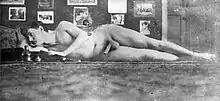
When war broke out in 1914, d'Adelswärd was asked to report for military service by the French authorities. He was found unfit for service by specialists in the French consulate in Naples and sent to a hospital for opium addiction. It was reported that he secretly used cocaine while in hospital to compensate for opium. At that time he met Italian sculptor Vincenzo Gemito. After d'Adelswärd came back to Capri, doctors declared him incurably ill. He mostly spent his days without leaving the villa, either working in his study or using opium in the smoking room, which was called his Opiarium by the Naples newspaper Il Mattino.
In 1920, d'Adelswärd met fifteen-year-old Corrado Annicelli, son of a notary from Sorrento, who came for a vacation to Capri with his parents.
He spent the rest of his life based in Capri, and died there in 1923 – allegedly by suicide achieved through drinking a cocktail of champagne and cocaine. His ashes are conserved in the non-Catholic cemetery of Capri. His lover, Nino Cesarini, returned to Rome.
_2011-10-20.jpg.webp)
Lord Lyllian
Lord Lyllian, published in 1905, is one of d'Adelswärd's more important novels, satirizing the scandal around himself in Paris, with touches of the Oscar Wilde affair thrown in for good measure. The hero, Lord Lyllian, departs on a wild odyssey of sexual debauchery, is seduced by a character who seems awfully similar to Oscar Wilde, falls in love with girls and boys, and is finally killed by a boy. The public outcry about the supposed Black Masses is also caricatured. The work is an audacious mix of fact and fiction, including four characters that are alter egos of d'Adelswärd himself.
Lord Lyllian was translated and first published in English in 2005.[8]
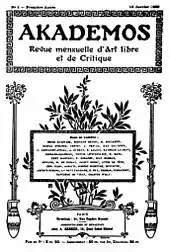
Akademos revue
Akademos. Revue Mensuelle d'Art Libre et de Critique (1909)[9] was d'Adelswärd's short-lived attempt at publishing a monthly literary journal. It was a periodical of a luxurious kind, each issue printed on several sorts of deluxe paper, with contributions by well-known authors, like Colette, Henry Gauthier-Villars, Laurent Tailhade, Josephin Peladan, Marcel Boulestin, Maxim Gorky, Georges Eekhoud, Achille Essebac, Claude Farrère, Anatole France, Filippo Tommaso Marinetti, Henri Barbusse, Jean Moréas and Arthur Symons.
In each issue, as is clear from d'Adelswärd's letters to Georges Eekhoud,[10] a homosexual element was carefully introduced: a poem, an article, or a hint in the magazine's serial Les Fréquentations de Maurice by Boulestin. As a magazine with homosexual agenda it was the first of its kind in the French language, although only about 10% of Akademos may be counted as homosexual. In its 'gay' content it trod similar ground to that of the German journal, Der Eigene, published between 1896 and 1931 by Adolf Brand. This is not a coincidence, as d'Adelswärd studied the German publications that tried to push for the social acceptance of homosexuality before launching Akademos. Also he corresponded with Brand and Magnus Hirschfeld.
Akademos lasted only one year—there were twelve monthly issues, amounting to some 2,000 pages. Perhaps its production costs were too great; but in a letter to Eekhoud, d'Adelswärd complained of the lack of interest of the press and the public;[10] and a general hostility from press or society cannot be ruled out.
Further reading
Books by Jacques d'Adelswärd-Fersen
- Conte d'amour (1898), poetry
- Chansons légères (1900), collection of poetry
- Musique sur tes lèvres (Ebauches et Débauches) (1901)
- L'Hymnaire d'Adonis: à la façon de M. le marquis de Sade (1902)
- Notre-Dame des mers mortes (Venise) (1902)
- Les cortèges qui sont passés (1903)
- L'Amour enseveli: poèmes (1904)
- Lord Lyllian (1905), novel (republished Montpellier (France) QuestionDeGenre/GKC, 2011 with a preface by Jean de Palacio and postface by Jean-Claude Féray)
- Ainsi chantait Marsyas... (1907)
- Une jeunesse (1907)
- Le baiser de Narcisse (1907), novel (republished in 1912 with illustrations by Ernest Brisset)
- Et le feu s'éteignit sur la mer (1909)
- Hei Hsiang (Le parfum noir) (1921)
 Cover of Lord Lyllian
Cover of Lord Lyllian Cover of Le baiser de Narcisse
Cover of Le baiser de Narcisse Title page
Title page Beginning of a chapter
Beginning of a chapter Illustrations
Illustrations


 Cover of Hei Hsiang
Cover of Hei Hsiang
Biographical
- Jacques Perot: Le destin français d'une famille suédoise: les barons Adelswärd (Bulletin du musée Bernadotte, no. 26, 1986), pp. 13-29.
- Patrick Cardon, ed: Dossier Jacques d'Adelswärd-Fersen (1993, Lille, Cahiers Gay-Kitsch-Camp).
- Norman Douglas: Looking Back: An Autobiographical Excursion (1933), pp. 358-366.
- Wolfram Setz, ed: Jacques d'Adelswärd-Fersen – Dandy und Poet (2006, Bibliothek Rosa Winkel). ISBN 3-935596-38-3
- James Money: Capri: Island of Pleasure (1986).
- Robert Aldrich: The Seduction of the Mediterranean (1996, Routledge), pp. 124-130 and 243-244. ISBN 0-415-09312-0
- Viveka Adelswärd: "Alltför adlig, alltför rik, alltför lättjefull - Jacques d'Adelswärd Fersen" (2014, Carlssons), pp. 1-201. ISBN 978 91 7331 647 7
- Gianpaolo Furgiuele: Jacques d'Adelswärd-Fersen. Persona non grata (2015, Lille-Paris, Ed. Laborintus). ISBN 979-10-94464-06-9
- Jamie James: Pagan Light: Dreams of Freedom and Beauty in Capri (2019, Farrar, Straus and Giroux). ISBN 9780374142766
Fictionalized
- Edwin Cerio: Il Marchese di Pommery, c. 1927
- Alfred Jarry: La Chandelle verte, 1969
- Compton Mackenzie: Vestal Fire, 1927
- Edward Prime-Stevenson: Out of the Sun, 1913
- Roger Peyrefitte: L'Exilé de Capri, 1959
Film
- Capri – Musik die sich entfernt, oder: Die seltsame Reise des Cyrill K. Archived 2006-10-29 at the Wayback Machine, 1983. — Made-for-TV movie directed by Ferry Radax for the WDR featuring d'Adelswärd-Fersen, Nino Cesarini, and other historical Capri celebrities.
- Music video of soprano Nicole Renaud singing d'Adelswärd-Fersen's poem, Mon cœur est un bouquet, shot in super 8 film at Villa Lysis, Capri, by Karine Laval.
Music
- The lyrics of the song Les amants solitaires by French soprano Nicole Renaud consist of four poems by d'Adelswärd-Fersen.
References
- "Cimitero Acattolico". Capri Tourism. Genzia Regionale Campania Turismo. Retrieved 16 July 2021.
- Ogrinc, Will H.L. "Frère Jacques: A Shrine To Love And Sorrow" (PDF). Archived from the original (PDF) on 16 September 2020. Retrieved 16 July 2021.
- "Pornographie mondaine". Le Rappel. 12 July 1903.
- Robb, Erber, George, Nancy (1999). Disorder in the Court: Trials and Sexual Conflict at the Turn of the Century. Springer. pp. 199–200. ISBN 9781403934314.
{{cite book}}: CS1 maint: multiple names: authors list (link) - Peyrefitte, Roger (1977). Propos secrets. Albin Michel. p. 362. ISBN 978-2226005021.
- "Un scandale Parisien". Le Figaro. 10 July 1903. Retrieved 3 December 2017.
- Amendola, Giorgio (2001). Una scelta di vita. BUR Biblioteca Univ. Rizzoli. ISBN 978-8817126106.
- d'Adelswärd-Fersen, Jacques. "Lord Lyllian: Black Masses". elysiumpress.com. Retrieved 2017-12-04.
- See Mirande Lucien: Akademos. Jacques d'Adelswärd-Fersen et 'la Cause homosexuelle'. Lille, Cahiers Gay-Kitsch-Camp, 2000 (p. 152), which reprints some of the key articles of the magazine. Akademos itself is extremely rare nowadays.
- Cardon, Patrick (1993). Dossier Jacques d'Adelswärd-Fersen. Lille: Cahiers Gay-Kitsch-Camp. pp. 59–67.
External links
- Will H.L. Ogrinc, Frère Jacques. A shrine to love and sorrow. Jacques d'Adelswärd-Fersen (1880-1923). Fourth, revised edition. Retrieved August 20, 2023.
- Article about the book "L'hymnaire d'Adonis" of Jacques d'Adelswärd-Fersen (in Spanish)
- Pictures of Villa Lysis today
- Nicole Renaud & Mario Bindi "Les amants solitaires" based on Jacques d'Adelswärd-Fersen poem
- Massimo Colella, Profilo biografico di attori partenopei del XX secolo: VI. Corrado Annicelli, 2022 (https://www.centrostuditeatro.it/2022/03/corrado-annicelli/).
Digitized books
- Scans of books by d'Adelswärd-Fersen at Gallica digital library (in French)
- The premiere issue of Akademos (in French)
- Issues #7 through #12 of Akademos at Gallica digital library (in French)